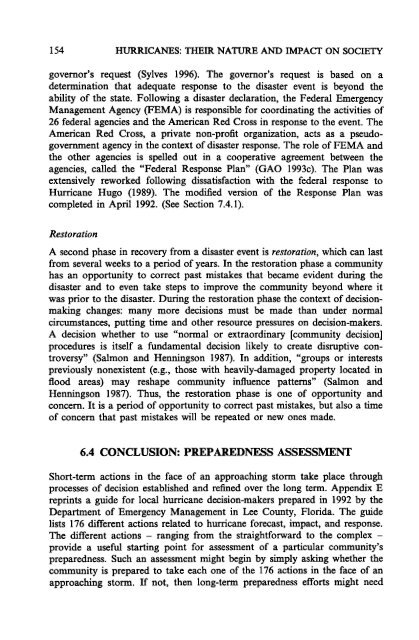Hurricanes: Their Nature and Impacts on Society - Climate Science ...
Hurricanes: Their Nature and Impacts on Society - Climate Science ...
Hurricanes: Their Nature and Impacts on Society - Climate Science ...
Create successful ePaper yourself
Turn your PDF publications into a flip-book with our unique Google optimized e-Paper software.
154 HURRICANES: THEIR NATURE AND IMPACT ON SOCIETY<br />
governor's request (Sylves 1996). The governor's request is based <strong>on</strong> a<br />
determinati<strong>on</strong> that adequate resp<strong>on</strong>se to the disaster event is bey<strong>on</strong>d the<br />
ability of the state. Following a disaster declarati<strong>on</strong>, the Federal Emergency<br />
Management Agency (FEMA) is resp<strong>on</strong>sible for coordinating the activities of<br />
26 federal agencies <str<strong>on</strong>g>and</str<strong>on</strong>g> the American Red Cross in resp<strong>on</strong>se to the event. The<br />
American Red Cross, a private n<strong>on</strong>-profit organizati<strong>on</strong>, acts as a pseudogovernment<br />
agency in the c<strong>on</strong>text of disaster resp<strong>on</strong>se. The role of FEMA <str<strong>on</strong>g>and</str<strong>on</strong>g><br />
the other agencies is spelled out in a cooperative agreement between the<br />
agencies, called the "Federal Resp<strong>on</strong>se Plan" (GAO 1993c). The Plan was<br />
extensively reworked following dissatisfacti<strong>on</strong> with the federal resp<strong>on</strong>se to<br />
Hurricane Hugo (1989). The modified versi<strong>on</strong> of the Resp<strong>on</strong>se Plan was<br />
completed in April 1992. (See Secti<strong>on</strong> 7.4.1).<br />
Restorati<strong>on</strong><br />
A sec<strong>on</strong>d phase in recovery from a disaster event is restorati<strong>on</strong>, which can last<br />
from several weeks to a period of years. In the restorati<strong>on</strong> phase a community<br />
has an opportunity to correct past mistakes that became evident during the<br />
disaster <str<strong>on</strong>g>and</str<strong>on</strong>g> to even take steps to improve the community bey<strong>on</strong>d where it<br />
was prior to the disaster. During the restorati<strong>on</strong> phase the c<strong>on</strong>text of decisi<strong>on</strong>making<br />
changes: many more decisi<strong>on</strong>s must be made than under normal<br />
circumstances, putting time <str<strong>on</strong>g>and</str<strong>on</strong>g> other resource pressures <strong>on</strong> decisi<strong>on</strong>-makers.<br />
A decisi<strong>on</strong> whether to use "normal or extraordinary [community decisi<strong>on</strong>]<br />
procedures is itself a fundamental decisi<strong>on</strong> likely to create disruptive c<strong>on</strong>troversy"<br />
(Salm<strong>on</strong> <str<strong>on</strong>g>and</str<strong>on</strong>g> Hennings<strong>on</strong> 1987). In additi<strong>on</strong>, "groups or interests<br />
previously n<strong>on</strong>existent (e.g., those with heavily-damaged property located in<br />
flood areas) may reshape community influence patterns" (Salm<strong>on</strong> <str<strong>on</strong>g>and</str<strong>on</strong>g><br />
Hennings<strong>on</strong> 1987). Thus, the restorati<strong>on</strong> phase is <strong>on</strong>e of opportunity <str<strong>on</strong>g>and</str<strong>on</strong>g><br />
c<strong>on</strong>cern. It is a period of opportunity to correct past mistakes, but also a time<br />
of c<strong>on</strong>cern that past mistakes will be repeated or new <strong>on</strong>es made.<br />
6.4 CONCLUSION: PREPAREDNESS ASSESSMENT<br />
Short-term acti<strong>on</strong>s in the face of an approaching storm take place through<br />
processes of decisi<strong>on</strong> established <str<strong>on</strong>g>and</str<strong>on</strong>g> refined over the l<strong>on</strong>g term. Appendix E<br />
reprints a guide for local hurricane decisi<strong>on</strong>-makers prepared in 1992 by the<br />
Department of Emergency Management in Lee County, Florida. The guide<br />
lists 176 different acti<strong>on</strong>s related to hurricane forecast, impact, <str<strong>on</strong>g>and</str<strong>on</strong>g> resp<strong>on</strong>se.<br />
The different acti<strong>on</strong>s -ranging from the straightforward to the complex -<br />
provide a useful starting point for assessment of a particular community's<br />
preparedness. Such an assessment might begin by simply asking whether the<br />
community is prepared to take each <strong>on</strong>e of the 176 acti<strong>on</strong>s in the face of an<br />
approaching storm. If not, then l<strong>on</strong>g-term preparedness efforts might need














